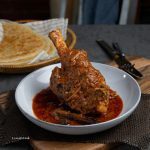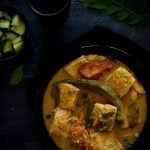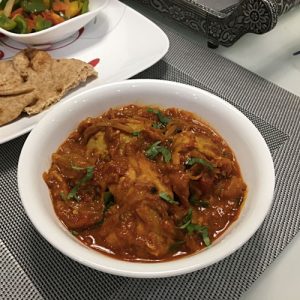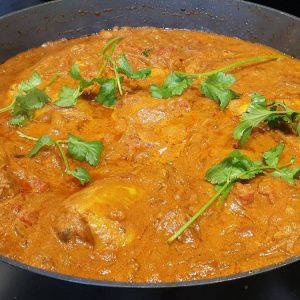Chicken Chitarnee, an Indian Jewish Curry, is a favourite with my family. It is an onion and tomato based curry that is spiced up with the use of a very few Indian spices and lots of lemon juice and vinegar. The result is a beautifully tangy curry with definite hints of spices.
Estimated reading time: 7 minutes

Early Jews in India
The curry comes from the Jewish community in India. Although a minority religion, Judaism was one of the earliest foreign religions to travel to India in recorded history. The following excerpt is from The Indian Express:
“Jews in India, unlike those across the globe, are divided into three distinct groups as per their geographical location and origin myths in the country — the Cochin Jews, the Bene Israeli and the Baghdadi Jews” (as in Baghdad, Iraq). “Each of these three categories arrived at different points in time and formed their Jewish identity as per the historical forces operant in India at that time.”
The earliest known Jewish arrival, in the 2nd Century BCE, according to legend, were the Bene Israel, via a shipwreck, whose history is now entwined with the myth of the 10 lost tribes of Israel. It is fascinating, if history interests you, whatever your religious inclination. Click on the Indian Express link above to read more, and there is a whole lot of literature on the net, sometimes conflicting, about the origin and progress of the Indian Jews.
Then there were the Sephardic Jews who settled in south India, namely Goa, Chennai (Madras) and along the Malabar Coast. Sephardic Jews are European Jews who fled the Spanish Inquisition in Spain and Portugal in the 15th and 16th centuries.
And since I learnt it in Singapore where I grew up, let me just mention that there is a significant minority Jewish population in Singapore. The first wave of Jews to Singapore was sometime in the 18th century, and were the Baghdadi Jews.

Singaporean Jews
With that short background, let me get back to the Chicken Chitarnee recipe itself. I learnt to cook this recipe when I was about 17 years old, in a friend’s kitchen, with her mum.
Hana and her family were Indians and in the early days of knowing her, I just assumed that with a name like that, she was a Christian, like some of my other Indian friends. One or two faux pax later, I learnt all about the Indian Jewish community and their presence in Singapore.
This recipe was from Hana’s maternal grandmother, who was a Sephardic Jew. Hana’s dad, however, claimed that his mum used to cook the same recipe too, although with a little more spice, and his mum belonged to the Baghdadi Jews!
So whatever specific Jewish origin the Chicken Chitarnee has, I can’t tell you for certain, as there isn’t a whole lot of literature about it out there. Suffice it to say, it is most certainly of Indian Jewish origin.
Is Chicken Chitarnee Sephardic Jew or Baghdadi Jew in origin?
Having said that, let me make an educated guess or two. The massive use of tomatoes here reminds me of the Portuguese Frango com Molho de Tomate, Chicken in Tomato Sauce. And didn’t the Sephardic Jews settle in Goa, whose cooking is tangy with its liberal use of vinegar?
And along the way, as they discovered Indian spices, it was only natural that some of those spices would find their way into the chicken in tomato sauce, resulting in what we know today, as Chicken Chitarnee.
What do you think?
I reckon Chicken Chitarnee is a Sephardic Jewish recipe.
Chicken Chitarnee Recipe
Hana and I were classmates, and going over to her place for lunch was not an uncommon affair, as her house was a mere 10 minutes away from school while mine was a whole hour. As I was already cooking by that age (growing up with one’s granny does that), learning how to cook this beautifully sour, spiced and sweet curry was always going to happen.
I’m glad I did, as it is something I still cook today, 30 years later, and as mentioned above, it’s a firm family favourite. Everybody goes yay, when I mention I’m cooking it!

How to Cook Chicken Chitarnee
There isn’t a whole lot of things to note for this recipe, it’s pretty straightforward and easy. It is a thick curry, with the chopped up onions and tomatoes making up the sauce. You can add a small amount of water to it, if you would like a little more sauce, no more than 125ml (1/2 cup) though.
Chicken
As with all chicken curries and stews, meat on the bone is going to give you the best result, as the bones lend depth to the sauce. Use a whole chicken if you like, but I have always preferred a mix of portions, like thighs, drumsticks and breasts to make up the total weight for the meat.
Oil
Use vegetable oil, if you like, that’s how Hana’s mum made it, I’ve gone for olive oil here, for no particular reason. Don’t use coconut oil though, it will change the flavour.
Beef Chitarnee or Lamb Chitarnee
You can use any meat you like in this, like beef or lamb, but adjust the cooking time. Your red meat will need 2-3 hours of cooking time, which means that you will have to add water to it as the meat is cooking, to prevent the curry from drying up. 250ml (1 cup) should do the trick, but use more if need be.
Vegetarian Chitarnee
Just add curry friendly vegetables like potatoes, aubergines (eggplant), capsicums (bell pepper) and courgettes (zucchini) or any others, even beans and pulses. Adjust the cooking time as necessary. Potatoes will need more time, but not if they are chopped into small cubes.
Well, that’s it, folks, what are your plans for the weekend? Whatever it is, I wish you a good one!
If you like the recipe, don’t forget to leave me a comment and that all important, 5-star rating! Thank you!
And if you make the recipe, share it on any platform and tag me @azlinbloor.
Lin xx
More Curry Recipes



Images from LinsFoodies







Chicken Chitarnee, an Indian-Jewish Recipe
Ingredients
- 1 kg 2.2 lb chicken portions (a mix of thighs, breasts and drumsticks)
- 2 Tbsp EV olive oil
- 2 tsp sugar
- 5 Tbsp fresh lemon juice
- 2 Tbsp white wine vinegar or clear vinegar
- 1 Tbsp tomato purée
Aromatics and Vegetables
- 6 large onions halved, then sliced
- 6 cloves garlic finely chopped
- 5 cm (2" ginger, finely chopped
- 2 mild fresh green chillies left whole (go for hot, if you fancy a spicy curry)
- 800 g chopped tomatoes 2 x (400g/14 oz) cans
- a small handful fresh coriander leaves (cilantro) chopped
Spices
- 1 Tbsp turmeric powder
- 2 Tbsp ground coriander
- 2 tsp cumin
- 1 tsp red chilli flakes
- 10 cardamom pods
- 1 tsp salt
- freshly ground black pepper
Instructions
- Sauté the onions and the sugar in the oil over medium heat for 3 minutes, until soft.
- Add the garlic, ginger, chillies, turmeric, coriander, cumin, chilli flakes, salt and cardamom and cook for 30 seconds.
- Add the chicken pieces in and coat well with the onion and spice mix. Cook for 2 minutes to let the chicken take on a little flavour.
- Add the chopped tomatoes, tomato purée, 1 Tbsp vinegar and half the lemon juice, stir to mix, and bring to a boil. Lower the heat, cover and simmer for 40 minutes until the chicken is cooked through.
- Turn the heat off and add the rest of the vinegar and lemon juice in, and stir to mix.
- Finish off with freshly ground black pepper and lots of coriander leaves (cilantro).


Greetings from Romania. I lived in Israel for 7 years and I have not seen this recipe. The truth is that Moroccan recipes predominate. I like your recipe and I will definitely make it because I like Indian and Middle Eastern flavors. This does not mean that I do not try from other regions. I will try brown sugar for this recipe. All the best.
Hi Noru, this is not an Israeli recipe, so I’m not surprised you didn’t find it there. It’s Indian but within their Jewish community. However, it’s also a long forgotten recipe, and something only a few families will still remember and cook.
Let me know what you think about it.
can I use chicken without bones, my family do not like them? this looks like a lovely curry 🙂
Yes, absolutely, Sandi. Let me know how it goes.
Two major issues which made me give you 3 Stars.
1. Is the unnecessary added Sugar, because there’s plenty of natural sugars in onions.
2. I would Brown the Chicken pieces first before the onions, keep aside, or fry them separately, then add them to the fried onions as per your initial method.
Otherwise, everything is perfect, please try it to see my point.
Thanks
Cooking is an art as well as a very personal thing. While I see your point, it’s not really something that I haven’t done in other recipes. Sugar with the onions is a complementary exercise, meant to enhance. Browning – in some recipes, I brown the meat first, and separately. But not in this one.
Hello Azlin,
Like always, more than a recipe you always write great. Love to read it
Thank you, and I’m so glad to be in touch with you again!
Wow, really enjoyed reading this. Have printed the recipe, so I won’t forget to shop for it! Planning to cook it this weekend. Wish me luck!
Thank you, Steve. How did it go?
Hello Azlin, this recipe sounds divine, I want to make it over the coming weekend.
I have 2 questions, How do you prep the 10 cardamoms and is it skin on or off the chicken.
Thanks
Hi Gilda, thanks for your message. The cardamoms are used, as they are, whole. You could pinch them open slightly, to allow the aroma of the seeds to seep out better. That was something my granny always did.
The chicken – with skin on is so much better, as the skin takes on the flavours of the curry. But if you prefer skin off, that works fine too. My husband would always take the skin off the chicken before eating.
Let me know how it goes.
Bookmarked. This reminds me of my maternal grandmother and great aunt who were born into the Baghdadi Jewish community in what is now Yangon in Myanmar at the turn of 20th century. AFAIK, we had never been through the west coast of India – a great, great, great grandfather had moved us directly from Baghdad to Rangoon in the early 19th c. However, there’s a further complexity in that my grandmother’s version of it may have come from her Persian Jewish mother.
But I’m glad to see a recipe for it, because both grandmother and great-aunt fiercely protected it, so it kind of died with them. Will try it and see if it reminds me of them. 🙂
Haha, you had to put a spanner in the works, didn’t you? Seriously though Mark, thanks for that information. Food history, as any history, is thoroughly fascinating and I’m rather intrigued by the fact that your family made this in Myanmar! I just had a quick read about the Jewish community in Burma under British rule.
The Persian angle is new to me. I’m not surprised though, its ancient hands reach far and wide. I have a quite a few Persian recipes on this site, and Persian stews do have a light, tangy feel to them, although the tang is usually from dried limes, rhubarb and barberries.
Let me know if you do make this and your thoughts on it, especially compared to your memories of your family recipe.
Is it 1 teaspoon or 2 tablespoon of tumeric
Hi Henry, it’s 1 tablespoon (Tbsp) ground turmeric. Not sure where you got the teaspoon (tsp) from. I looked through the whole recipe and can’t see it. I hope that helps. Let me know if I’ve missed something. And do let me know if you make it.
This is wonderful, Azlin. I thoroughly enjoyed the amazing background you gave to this curry and wow, what a recipe! First time on your blog, but a fan for life!
Thank you, Alex, I appreciate that. Let me know if you decide to give it a try!
This is great presentations
Thank you!
Fabulous recipe and wonderful history lesson! I look forward to making this next week for our annual family Hannukah dinner. Any thoughts on making it a day in advance and then reheating (in oven or stovetop?)?
Thank you.
Hi Sheryl, thank you, pleased you think so.
Chicken chitarnee keeps well.
On the stove: add a little water and heat on medium-low for 5 minutes to bring to a simmer. Once it’s simmering, stir gently, so as not to break the soft pieces of chicken up, cook for another 5 minutes, covered, on low to let it heat through completely.
Oven: at 180C/350F, for 20 minutes, cover with a lid, or foil. Stir gently.
If you’re cooking with the express purpose of serving it the next day, I would stop cooking before the chicken meat comes off the bone. This is so the meat doesn’t all fall apart the next day when reheated.
I hope that helps. Happy Hanukkah to you and yours.
I can’t wait to try this. Yum!
Thank you Si, let me know how it goes!
Food history is a most intriguing topic, I love it, and I think it’s important for all of us to learn about what could be our roots! I only tried curries when I moved to South Africa and been in love since then. A dear friend introduced me to curries and sushi, he was such a foodie! Good memories!
I totally agree with you, Cynthia!
I love Indian curries, and I love how easy this recipe is. Pinning!
Thank you, Amelie!
This sounds like the perfect comfort meal!
Amongst other things!
Your photos are making me so hungry! It looks too good! The chicken is calling me name! I can tell this is full of flavor! I love highly seasoned foods!
Thank you, April.
I learned how to cook most of my favorite Mexican recipes from a dear friend, and every time I make them, I’m reminded of her. I love that you learned to make this curry in a similar way, and I can’t wait to try it. It looks delicious and perfect for the cold winter months.
Thank you Daniela, nothing like learning form the source!
Oh yumm, this is the kind of stick to your ribs meal I crave on a cool winter day! I will be bookmarking this for my meal plans, who doesn’t love a good curry?
Thank you!
ohhh I’ve been craving good curry for a while now!!! This is it! I’m making this for dinner. I love how this recipe is adjustable for any type of meat or no meat. Since we don’t usually have meat in the house. Thanks for the recipe!!
Thank you Tiffany, I hope you guys loved it!
THis looks so yummy! I will have to try it.
Thank you for this wonderful recipe and the story behind it. I read The Girl from Foreign, the memoir of an American graduate student who went to Pakistan and India in search of her heritage and she discovered the Jews of India, especially Cochin, in the process. Now I have a blogging friend whose grandfather lives in Cochin. I am eager to make your recipe. I enjoy your blog very much
That sounds like a really good tale, I must get hold of it. Thank you Allison!
Oh, I do love a good history lesson! Especially when it’s spiced up with great food! This curry sounds delicious. I particularly love the ginger and turmeric—that combination is dynamite!
Thank you, it sure is!
Wow, Lin, This sauce looks fantastic! I think I could easily be happy with this sauce over rice… so much flavor in there!
Thank you, Cat!
Wow, thank you for an amazing cultural and food history experience. I love your food blog for just this precise reason. It is so rich in content and the experience.
Thank you, George!
Saw this post on Pinterest and here I am! This is a really amazing post, Azlin, thank you for a super lesson in food and cultural history! I’ve never heard of this curry, and am really looking forward to making it for my family.
Thank you Maisy, let me know when you make it and what you think of it!